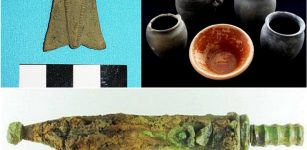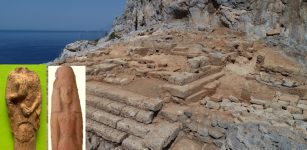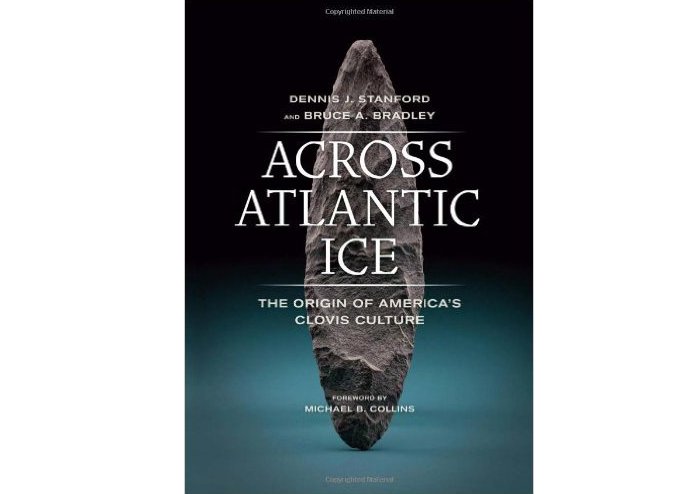Solutrean People: Were First Americans European Stone Age People?
Ellen Lloyd - AncientPages.com - Who were the first Americans? This question remains an unanswered and much-debated question. There are several promising theories, but several scientists say conclusive evidence is still missing.
Cro-Magnon artists painting in Font-de-Gaume,1920. Image: Charles R. Knigh
According to the Solutrean hypothesis, the first Americans were Stone Age Europeans who came to North America several thousand years earlier than the Ice bridge theory proposes.
The intriguing Solutrean theory raises a number of questions, such as: Where did these Europeans come from, and what happened to them? What evidence is there to support this claim?
The most widely accepted scientific theory is that sometime before 14,000 years ago, humans migrated from Siberia to Alaska using a "land bridge" that spanned the Bering Strait.
However, some scientists question the Land Bridge theory. One of them is the Smithsonian Institution anthropologist and Professor Dennis Stanford and Professor Bruce Bradley from Exeter University, who wrote the book Across Atlantic Ice: The Origin of America's Clovis Culture.
Smithsonian Institute anthropologist Dennis Stanford, left, and University of Exeter archaeologist Bruce Bradley examine knives from the last Ice Age. (Bonnie Jo Mount/Post)
Professors Stanford and Bradley believe that ancient Europeans traveled to North America across an Atlantic frozen by the Ice Age. They base their theory on stone tools discovered by archaeologists along the northeast coast of the USA.
These ancient tools are between 19,000 and 26,000 years and bear remarkable similarities to those made in Europe.
Professor Stanford said these mysterious Stone Age Europeans were known as the Solutreans, and they occupied Spain, Portugal, and southern France more than 20,000 years ago.
They paddled along an ice cap jutting into the North Atlantic and lived like Inuits, harvesting seals and seabirds.
'Ice Bridge Theory'
In time, the Solutreans spread across North America, hauling their distinctive blades with them and giving birth to the later Clovis culture, which emerged some 13,000 years ago.
According to archaeologist and paleontologist James Chatters, modern Native Americans closely resemble people of China, Korea, and Japan, but the oldest American skeletons do not. "This has led to speculation that perhaps the first Americans and Native Americans came from different homelands," Chatters said, "or migrated from Asia at different stages in their evolution."
Could these people have come from Europe?
On Chesapeake Bay islands, scientists unearthed blades, anvils, and other tools found stuck in the soil at least 20,000 years old. Professor Stanford said these ancient blades strongly resemble those found at dozens of Solutrean sites from the Stone Age in Spain and France.
The Solutreans left behind rock art, but no skeletons have been found, so unfortunately, no DNA is available to study.
Professor Stanford's theory has been met with criticism. When Professor Stanford proposed this "Solutrean hypothesis" in 1999, his colleagues rejected it. One prominent archaeologist suggested that Stanford was throwing his career away.
Who were the first humans to inhabit North America? According to the now familiar story, mammal hunters entered the continent some 12,000 years ago via a land bridge that spanned the Bering Sea. Distinctive stone tools belonging to the Clovis culture established the presence of these early New World people. But are the Clovis tools Asian in origin? Drawing from original archaeological analysis, paleoclimatic research, and genetic studies, noted archaeologists Dennis J. Stanford and Bruce A. Bradley challenge the old narrative and, in the process, counter traditional—and often subjective—approaches to archaeological testing for historical relatedness. The authors apply rigorous scholarship to a hypothesis that places the technological antecedents of Clovis in Europe and posits that the first Americans crossed the Atlantic by boat and arrived earlier than previously thought. Supplying archaeological and oceanographic evidence to support this assertion, the book dismantles the old paradigm while persuasively linking Clovis technology with the culture of the Solutrean people who occupied France and Spain more than 20,000 years ago. Read more
His theory has been revived many years later, and more scientists are curious and willing to investigate the Solutrean hypothesis further.
"The reason people don't like the Solutrean idea is the ocean," Professor Stanford said. No Solutrean boats have been found. But given that people arrived in Australia some 60,000 years ago — and they didn't walk there — wood-frame and seal-skin boats were possible, Stanford argued.
Scientists also point out that another problem with the Solutrean hypothesis is that at the end of the last ice age, the polar ice cap may not have extended all the way across the Atlantic, leaving iceberg-strewn gaps of open water for the Solutreans to navigate as they headed West for unknown reasons.
Many scientists think the Solutreans hypothesis is based on scant evidence, but it is naturally an interesting hypothesis that is worth exploring if one wants to learn more about the first Americans.
Written by - Ellen Lloyd – AncientPages.com
Updated on February 6, 2023
Copyright © AncientPages.com All rights reserved. This material may not be published, broadcast, rewritten or redistributed in whole or part without the express written permission of AncientPages.com
Expand for referencesMore From Ancient Pages
-
 Rare Roman Brooch And A Miniature Sword – Unearthed
Artifacts | Jan 18, 2016
Rare Roman Brooch And A Miniature Sword – Unearthed
Artifacts | Jan 18, 2016 -
 Controversial Theory Suggests Ancient Egyptians Were Founders Of Chinese Civilization
Archaeology | Sep 5, 2016
Controversial Theory Suggests Ancient Egyptians Were Founders Of Chinese Civilization
Archaeology | Sep 5, 2016 -
 Why Was The Dmanisis Gora Fortress Community So Resilient In The Transition From The Bronze To Iron Age
Archaeology | Jun 5, 2023
Why Was The Dmanisis Gora Fortress Community So Resilient In The Transition From The Bronze To Iron Age
Archaeology | Jun 5, 2023 -
 Deciphered Ancient Stone Tablets Contain Sacred Knowledge That Could Re-Write History
Civilizations | Aug 28, 2018
Deciphered Ancient Stone Tablets Contain Sacred Knowledge That Could Re-Write History
Civilizations | Aug 28, 2018 -
 Sumerian ‘Mask Of Warka’ From Uruk: Sculptured Face May Depict Goddess Inanna
Featured Stories | Sep 15, 2016
Sumerian ‘Mask Of Warka’ From Uruk: Sculptured Face May Depict Goddess Inanna
Featured Stories | Sep 15, 2016 -
 Mysterious Hyksos People Rose To Power In Ancient Egypt Through Marriage And Not Invasion – Researchers Say
Archaeology | Apr 17, 2019
Mysterious Hyksos People Rose To Power In Ancient Egypt Through Marriage And Not Invasion – Researchers Say
Archaeology | Apr 17, 2019 -
 Who Said ‘Eureka’ First And Why?
Ancient History Facts | Feb 8, 2023
Who Said ‘Eureka’ First And Why?
Ancient History Facts | Feb 8, 2023 -
 Lady SAS – Ancient Skeleton Of Foreign Woman Found In Palenque – Who Was She?
Archaeology | Apr 11, 2023
Lady SAS – Ancient Skeleton Of Foreign Woman Found In Palenque – Who Was She?
Archaeology | Apr 11, 2023 -
 Nicholas Owen ‘Little John’ Who Paid Highest Price For His Ingenious, Camouflaged Places To Hide
Featured Stories | Dec 5, 2017
Nicholas Owen ‘Little John’ Who Paid Highest Price For His Ingenious, Camouflaged Places To Hide
Featured Stories | Dec 5, 2017 -
 Mythical Shield-Maidens Did Exist – Evidence Of Female Viking Warriors Discovered
Archaeology | Sep 9, 2017
Mythical Shield-Maidens Did Exist – Evidence Of Female Viking Warriors Discovered
Archaeology | Sep 9, 2017 -
 Mysterious Stone Of The Sky God: Krishna’s Butter Ball Defies All Laws Of Physics
Featured Stories | Aug 20, 2014
Mysterious Stone Of The Sky God: Krishna’s Butter Ball Defies All Laws Of Physics
Featured Stories | Aug 20, 2014 -
 Unusual And Well-Preserved Skeleton Discovered In Ancient Pompeii Sheds New Light On The Cultural Life Of The City
Archaeology | Aug 18, 2021
Unusual And Well-Preserved Skeleton Discovered In Ancient Pompeii Sheds New Light On The Cultural Life Of The City
Archaeology | Aug 18, 2021 -
 Faces Of Queen Nefertiti And King Akhenaten Reconstructed Using Artificial Intelligence
News | Mar 22, 2021
Faces Of Queen Nefertiti And King Akhenaten Reconstructed Using Artificial Intelligence
News | Mar 22, 2021 -
 Prometheus ‘Fire Bringer’ – Hero Stealing Fire From Gods Giving It To Mortals
Featured Stories | Sep 5, 2018
Prometheus ‘Fire Bringer’ – Hero Stealing Fire From Gods Giving It To Mortals
Featured Stories | Sep 5, 2018 -
 King Sanakht: Mysterious Ancient Egyptian Pharaoh Was A ‘Giant’ – Scientists Say
Archaeology | Aug 9, 2017
King Sanakht: Mysterious Ancient Egyptian Pharaoh Was A ‘Giant’ – Scientists Say
Archaeology | Aug 9, 2017 -
 Who Can Solve The Shackleton Scribble Mystery?
Artifacts | Sep 13, 2017
Who Can Solve The Shackleton Scribble Mystery?
Artifacts | Sep 13, 2017 -
 Ancient Runestones Reveal A Surprising Viking Secret – Scientists Say
Featured Stories | Jul 21, 2024
Ancient Runestones Reveal A Surprising Viking Secret – Scientists Say
Featured Stories | Jul 21, 2024 -
 Secrets Of The Ancient Temple Of Dimitra At The Acropolis Of Falasarna Revealed By Archaeologists
Archaeology | Nov 19, 2022
Secrets Of The Ancient Temple Of Dimitra At The Acropolis Of Falasarna Revealed By Archaeologists
Archaeology | Nov 19, 2022 -
 On This Day In History: Fascinating Prague Astronomical Clock Mentioned For The First Time – On Oct 9, 1410
News | Oct 9, 2016
On This Day In History: Fascinating Prague Astronomical Clock Mentioned For The First Time – On Oct 9, 1410
News | Oct 9, 2016 -
 Altai Mountains Were Home To Porcupines 30,000 Years Ago
Archaeology | Mar 14, 2017
Altai Mountains Were Home To Porcupines 30,000 Years Ago
Archaeology | Mar 14, 2017




